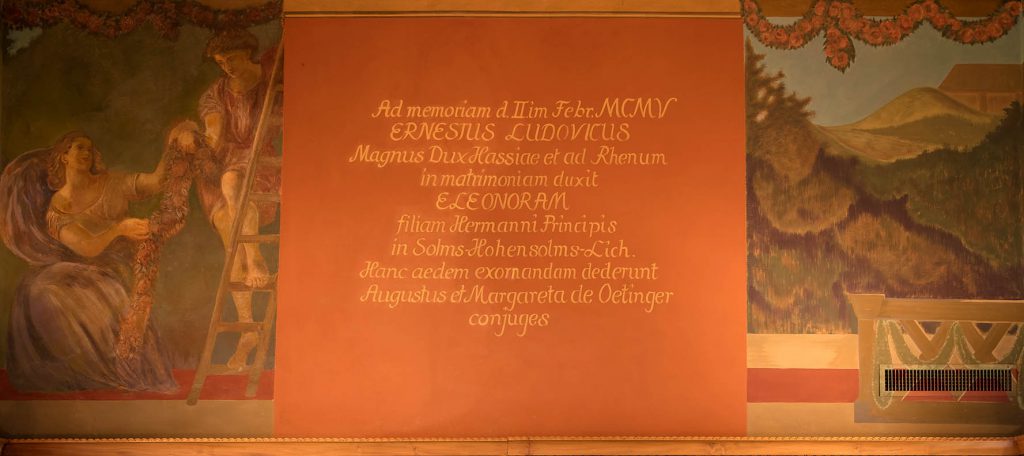In the Grand Duchess’ room on floor 5 (the so-called “Wedding Room”) the area above the wall panelling is covered by a large, fabulous wall painting. It depicts a princely wedding scene rich in figures and painted in neo-Renaissance style. The painter of the wall frieze was Philipp Otto Schäfer (born in 1868 in Darmstadt) who admired Makarts. On behalf of the Darmstadt Technical University he had created a number of large-size decorations involving numerous figures and had received several awards, e.g. at the 1900 World Exhibition in St. Louis. The paining tells the story of the wedding of the princely couple.

The ceremonial wedding procession extends over three of the four walls and culminates in the depiction of the wedding couple under a canopy on the northern front wall. Here, the Grand Duke is presenting the ring to his bride, the “Licher Lorchen”, as she was called. Both are represented in an idealized way and are wearing medieval costumes. The couple is surrounded by putti who are dancing and playing the flute, with the dark silhouette of the Odenwald being visible in the background. The carefully conceived story is developing on the walls to the left and to the right of the two main figures: Sitting, standing and kneeling men and women who are busy hanging up garlands or paying homage to the princely couple.

In the left corner, the god of pranks is waving a fool’s sceptre with bells. Originally, he was characterized by the three-part jester’s cap and bells – as can be seen on a photocopy of Schäfer’s draft of this wall painting. Children are surrounding him. The building in the background is probably Breuberg Castle.
Next to this follows a scene depicting the homage paid by the three Hessian provinces at the time: On the left, Wormatia, the personification and Goddess of the city of Worms wearing a mural crown and wine leaves in her hair, putti dancing in front of her. She embodies Rheinhessen. Next to her, Starkenburg Castle, depicted as a female figure, is holding a spear as a sign of strength, her hair is decorated with an oak wreath. She represents South Hesse. Behind her, only half visible, the personified city of Friedberg is standing as the representative of Upper Hesse. In the original draft, this female figure was supposed to hold a basket of fruit in her hands (Darmstädter Tagblatt dated 17 May 1909), but it was replaced by a model of the castle.
To the right, two female figures are resting at the feet of the provinces: the one on the left is, without doubt, the Muse of Music, as she is holding a lyre in her hands. The female figure on her right is here depicted as Justitia, while in the draft, a bearded river god holding a jug under his arm is placed in her stead. It can be assumed that the original intention to represent Father Rhine in this place went hand in hand with the idea to represent the entire Rhine valley as a background to the painting, as, on clear days, in can be seen from here. The two knights and the young boy standing to the right are probably symbolizing nobility, as, just around the corner, Lich castle, Eleonore’s ancestral seat, comes into sight behind the bride. In the same way, Lichtenberg castle which is situated in the Odenwald appears behind the bridegroom.

To the right, around the corner, the allegories of knighthood, youth and old age, seen from left to right, are depicted. Next to these, follows a female figure probably symbolizing fertility . Finally, six female figures are pictured to the right. As they are lacking any apparent attributes, it is not clear who or what they are representing. They are making garlands, while putti are bustling among them. Just opposite these six women, the three Hessian provinces are depicted.
A detail in the description of the opening ceremony refers to “the six (most beautiful) Hessian cities”. This would be in line with the painting’s general concept. Accordingly, the six female figures are supposed to represent Gießen and Friedberg for Upper Hesse, Frankfurt and Offenbach for Starkenburg and, finally, Mainz and Worms for Rheinhessen (as stated by Prof. Franz, National Archives). The landscape in the background is probably representing the rolling hills of the Bergstraße which is also visible from this point.

There are two more coats of arms in this room of which only one has as yet been identified: It is the Darmstadt coat of arms in the front corner of the Western wall. The crown, however, is still lacking, as it was added only in the year 1917 when the Grand Duke celebrated the 25th anniversary of his reign. The coat of arms in the Northern corner of the Eastern wall is still waiting for interpretation.



